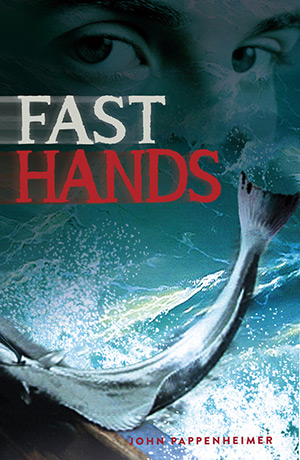
Young adult novel inspired by stories told around galley tables in Ketchikan
December 11, 2014
Author John Pappenheimer arrived in Ketchikan in 1971, when Grumman gooses were still landing on their bellies in front of the town, a sawmill operated day and night on the waterfront, and fishermen, loggers, cold storage and mill workers defined the town. “I wanted to see the Alaska’s coast up close,” Pappenheimer reminisced. “I could have paid to see Alaska from a cruise ship—but they only provide distant balcony seats. I wanted a ring side seat and I figured a fishing boat with a few feet of free board and a knee high railing was the ticket. I was not disappointed. “In writing Fast Hands, I wanted to give young adults a ring side seat to fishing off the coast from the Dixon Entrance to the Gulf of Alaska. Fast Hands begins when a Seattle judge gives 16-year-old Gus Pedersen a choice between eight months in a juvenile facility and summer fishing with an uncle he has never met. Gus chooses what he thinks is the easier of the two options. On his first morning in Ketchikan, Gus Pedersen is shaken awake. He is told to take the halibut boat Hamilton out to Cape Muzon before waking his uncle and crew. Gus assumes there has been some mistake. He has never been on a boat bigger than a rented canoe; he doesn’t know port from starboard; he has no idea how to read a chart; and it is still pitch dark outside. “As farfetched as it may sound,” author John Pappenheimer told Sitnews, “Something very similar happened to a friend of mine from Ketchikan when he was a young teenager and totally unprepared to take large boat with a direct reversible engine out to the open ocean. The boat’s owner had pulled the skipper and engineer out of a bar. He worried that, if they were woken too soon, they would turn the boat around and head back to town. On that first halibut trip, Gus doesn’t appreciate the beauty and thrill of fishing off shore. He is only aware of the pain, the sleeplessness and the unrelenting push to keep up with three old Norwegians who are long inured to the hardships and the dangers of fishing. As seen through Gus’s eyes, the boat is an alien planet where misery is measured by an eternity of nanoseconds—and who can imagine an eternity? Exhausted and convinced that everyone on the boat is seriously demented, Gus Quits. But how do you quit on a fishing boat miles off shore? A quiet revelation from his uncle convinces Gus to return to work. To his surprise, his fellow crewmen accept him back without comment. Despite their gruff, seeming indifference, Gus realizes that the three Norwegians are actually watching out for him. They are schooling him the way they were schooled themselves at an even younger age. Back in Ketchikan, Gus encounters fresh challenges. He must avoid a seiner man who is gunning for him. He must learn to navigate the heart of Claire, a complicated woman with troubles of her own. He must help with an intervention after his uncle gets into one too many bar fights. And by summer’s end he must end a curse that has haunted his family ever since a boxing match in Bergen, Norway, in 1942. Author John Pappenheimer, who went on to found the Alaska Fisherman’s Journal, has an obvious affection for the fishing community. He is a sharp observer of the subtleties beyond first appearances of reticent fishermen. He delights in the sardonic observations and naïve disbelief of Gus who, on his first halibut trip believes he has a case for the Association for the Prevention of Cruelty to Teenagers. “Above all,” Pappenheimer told Sitnews, “ I want young readers to experience, even if only in their imaginations, the euphoria that Gus, Will (from Metlakatla) and Claire experience fishing the magnificent Fairweather grounds – just the three of them near the novel’s end. Their choice of music is blasting out on deck, and for Will, a Tsimshian, it is his first command.
On the Web:
|
|||
